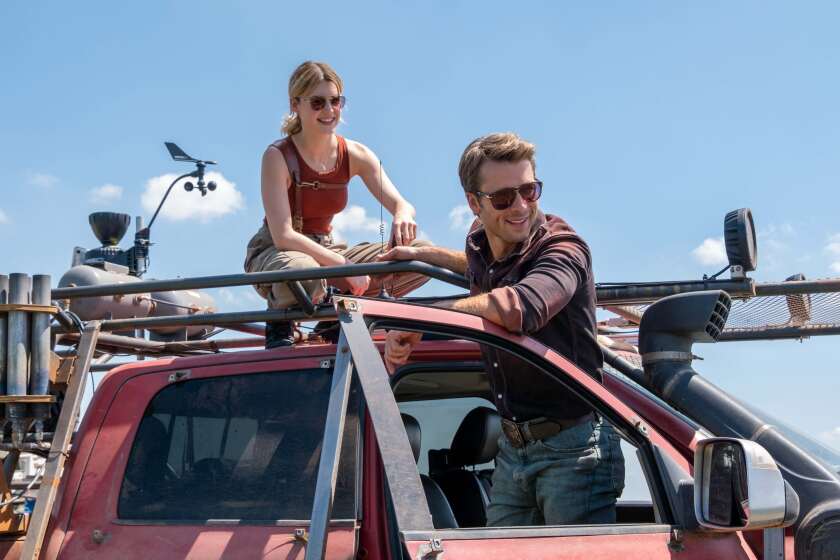Humor Too Dark for Its Own Good?
It began as the story of the guy you can’t get rid of--a cable television installer who is a troublesome pest but never dangerous.
By the time it reached the big screen with Jim Carrey as its star, however, “The Cable Guy” had taken on a far more sinister tone. The cable installer had become a menacing stalker, leaving audiences to ponder if they should laugh at his antics or simply recoil.
Today, as debate swirls throughout Hollywood over whether history will judge Carrey’s latest effort a hit or a miss, some are wondering if the filmmakers blundered in making the tone of the Columbia Pictures release so dark.
To its detractors, “The Cable Guy” symbolizes a trend in today’s humor, where laughter comes at the expense of victims and comedians troll for jokes in situations that are all-too disturbing in real life. Is stalking funny, they ask? Is beating up a guy in a restroom hilarious?
To its defenders, the movie is a daring attempt by Carrey, director Ben Stiller and writer-producer Judd Apatow to erect a “satiric thriller” that explores far grittier themes than the conventional mindless comedies Hollywood dispenses each summer.
“Some people didn’t get what they expected out of this movie, but that is just expectations,” co-producer Jeffrey A. Mueller said. “I think where Ben was going was for edgier satire, a more intelligent comedy. I think Jim was looking to push the envelope with respect to his audience and his comedic character. He wanted to move more from Jerry Lewis to Jack Nicholson.”
From “Pulp Fiction” to “Fargo,” today’s audiences are treated to uncomfortable humor, whether it is depicting men being sprayed with brain parts or a body being pulverized in a wood chipper.
Stiller believes there are subjects that should be taboo in comedy, but not many.
“I don’t think there is anything that we shouldn’t be allowed to laugh at except maybe killing children, rape or horrible things like that, which in no way could possibly be funny. But other than that, I don’t think there should be any rules. Stalking, obsessive-compulsive people, are all part of life. For me, I’m not that interested in just escapist humor that doesn’t have a connection with reality.”
*
Some believe that comedy began to change in the 1980s with the rise of the Harvard school and David Letterman, where comedians began making fun of others instead of themselves.
“It was humor from a superior vantage point, but it was funny,” said Ed Solomon, who co-wrote “Bill & Ted’s Excellent Adventure.”
There is no disputing that the tone of “The Cable Guy” dramatically darkened once Stiller, Carrey and Apatow came on board.
The original screenplay by Lou Holtz Jr. was a lighter comedy, where the cable guy (Chris Farley was originally attached to star) is a likable loser who intrudes upon the cable subscriber’s life, but never in a physically threatening way.
“When I read the original script . . . what I saw was an interesting setup for a film,” Stiller recalled, “but I didn’t have any interest in making that movie.”
“There was no physical humor,” Apatow said. “There wasn’t one physical joke in the entire [script], but we loved the idea of somebody who is really smart with technology invading somebody’s life.”
Stiller and Apatow envisioned a satire of psycho-thrillers such as “Cape Fear,” “Unlawful Entry” and “The Hand That Rocks the Cradle.” Into this mix would be thrown the cable guy, Stiller explained, “a person who has seen way too much TV, seen way too many movies and is playing out his life as if it were a film.”
“I think the movies we were making fun of were very mean-spirited,” Apatow said. “In ‘The Hand That Rocks the Cradle,’ Rebecca De Mornay’s character breast-feeds this woman’s baby that isn’t her own. In ‘Cape Fear,’ he kills their dog. So we are trying to come up with funny variations of that. In our version, [the cable guy] ruins a pickup basketball game, plays porno Password, gets his friend in jail. There are really only six punches in the entire movie.”
Holtz wrote four additional drafts after his original screenplay, each one darker than the previous--but never so dark that the cable guy became violent.
After Holtz left the project, Apatow took over the writing. (Apatow attempted and failed to persuade the Writers Guild of America to give him a screenwriting credit. Holtz declined to comment.)
A source familiar with the production said Apatow’s drafts were at times so dark that the studio “got them to lighten up the script considerably.”
“We took 90% of the elements out that Sony was concerned about,” Apatow said, “but we took them out as part of the natural evolution of our creative process. They really didn’t say, ‘This must come out.’ ”
Apatow said there were a number of scenes they experimented with but discarded either because they were too intense, weren’t funny enough or the film was running too long. Among these were:
* The cable guy luring one of the friends of the Matthew Broderick character to a secluded area and then jumping out and firing at him with a staple gun, stitching his rear end in the shape of a television.
* The cable guy, pretending to be a volunteer fireman, confronts Steven, telling him, “Don’t mess with me!,” and hurls a fireman’s ax.
* The cable guy rides up on a horse looking like the headless horseman, remarking that Ichabod Crane is on the Disney Channel all month. Then he leaps at Steven, who puts a rock to the cable guy’s head and threatens him until the cable guy says: “Luke, go to the dark side of the force!” (Apatow said the scene was shot in the rain in Griffith Park in 40-degree temperatures and the evil in Carrey’s eyes look too realistic.)
*
Stiller stressed that experimenting with scenes is a normal process in filmmaking, and added: “I shot every scene with a dark version and a light version because I knew it would all be in the tone.”
Stiller and Apatow say they do not think the movie is too dark, regardless of what critics say.
“People say this movie is dark, but it really isn’t that dark,” Stiller said, adding that some have criticized him for “not going far enough.”
One source familiar with the production said studio executives were concerned about the dark tone the script was taking, but felt they could not challenge Carrey.
“Columbia Pictures was not trying to make this guy psychotic and violent, but Columbia was put in a position where Carrey and Stiller were saying, ‘We’re going to do it this way.’ ”
But it is the ending atop a satellite dish and television tower that has caused some critics to scratch their heads and ask whether the filmmakers went too far.
“The challenge of the script is how can you make this guy likable,” said one source familiar with the project. “Any idiot can write a movie where a guy tries to kill you.”
Stiller said the studio was supportive throughout the production, but he admitted wondering whether Columbia would buy into the dark ending.
“I was surprised,” he said. “I thought they would freak out and go, ‘Wow, this is crazy!’ But they knew what the movie was about while we were making it. They didn’t make us change the ending.”
More to Read
Only good movies
Get the Indie Focus newsletter, Mark Olsen's weekly guide to the world of cinema.
You may occasionally receive promotional content from the Los Angeles Times.






